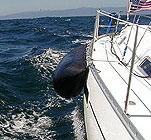Advantages
of Existing Internal Water Ballast Systems
Many new high performance racing and
cruising sailboats are being manufactured with built-in rigid
internal water ballast tanks to improve their upwind
performance, without sacrificing downwind performance.
This is accomplished by filling the windward ballast tank with
water while going upwind to stabilize the sailboat, and emptying
the ballast when going downwind for less weight. Reducing
the angle of heel not only increases performance but also
increases comfort and safety similar to sailing down wind.
The cockpit is much more comfortable and you have a safer
working platform, especially on the fore deck. Below deck
tasks such as cooking, using the head or sleeping (in improper
sea berths) are made safer and easier in heavy seas. Even
when just day sailing with friends and family it becomes more
comfortable -- everyone likes a nearly level boat! Reefing
is also minimized by stabilizing the boat in moderate conditions
and not having to depower the sails.
Examples of internal water ballast manufactured into high
performance cruising sailboats can be found in Roger Martin's 40
foot Gray Wolf, with the following advantages:
"with winds westerly at 15 to 18
knots. Our initial angle of heel, close reaching with
full main and 120 percent jib, was near 10 degrees. This
all but disappeared after Rodger scurried below and switched
on a Rule 3600 pump to fill the windward ballast tank.
Our speed subsequently increased by a knot, to say nothing of
our comfort level." "Each port and starboard tank holds
262 gallons (2,240 pounds)."
CRUISING WORLD magazine June 1997, page 91.
and also, in Steve Dashew's 80 foot Beowulf:
"Beowulf's 7,500 pounds of saltwater ballast, stored in side
tanks, reduces heeling by 8 degrees and adds several knots to
boat speed". CRUISING WORLD magazine
August 1998, page 36.
How Water Ballast Increases Boat Speed and
Comfort
Water ballast works by reducing the angle of heel on a
sailboat. This makes the keel, rudder and sails increase
their projected profile and lift in the horizontal direction
(less downward sail pressure), generating greater driving and
tracking forces that make the sailboat go faster. It also
reduces leeway (side slipping) and the resulting (hull form)
drag. Although there is additional drag from the hull with
the added ballast weight, it is minimal when compared to the
gain (also in water line length).
Modern sailboats that are light and have flat under
bodies gain the most performance from water ballast since they are
capable of going beyond their normal hull speed when
planing. Speeds beyond hull speed are generally achieved
going down wind in brisk conditions having a good driving force,
when the sailboat's bottom sections are kept flat on the water for
planing. The driving forces on a reach or upwind are not as
direct, making the sailboat heel, no longer presenting the flat
bottom sections of the vessel. Adding water ballast on the
windward beam while on a reach reduces the heeling angle, which
again presents a flatter bottom for planing and increases the
driving forces which make the sailboat go faster. Heavy
displacement sailboats have a substantial gain in performance with
water ballasting, although they are limited by their hull speed.
Light modern cruising sailboats also tend to have a harsh
motion in heavy seas. This can make it uncomfortable and
difficult to perform normal tasks on ocean passages, with
excessive heeling only aggravating the situation. By
adding additional water ballast weight on the windward beam,
rolling and tossing are dampened and more velocity is sustained
through oncoming waves. With slower and less internal
movement, as well as angle of heel, one has a more comfortable
and safer sea kindly ride in heavy seas, with less time spent at
sea with the added speed. Also, water ballast can be
placed on both sides of the sailboat to reduce rolling at
anchorage or on one side to remove the vessel from a grounding.
Advantages of New External Water Ballast System
The new external water ballast system attaches to most
sailboats in seconds without alterations, and can be moved from
one rail to another or from one similar size boat to
another. This system provides all the advantages of
internal water ballast for any existing sailboat.
Attempting to add internal water ballast tanks to an
existing boat would require major reconstruction and take up
valuable internal space, even when not in use. External
water ballast also provides better performance with the ballast
held further outward which has a greater stabilizing force for
the same quantity of water. External water ballast
requires no active pumping for the emergency release of water on
the leeward side of the boat and is also compliant with the 10
degree (heel) static rule for offshore safety (both sides
2x10°=20°).
Disney's
water ballast bags.
Disney's water ballast bags,
Sailing World.
Home page for Maxi Marine external water
ballast system.

Stability and What
Hangs In The Balance
As mentioned earlier, reaching speed is directly related to the
heeling angle of a sailboat. Some expensive high-tech
solutions involve lightening the sail rig by the use of
Kevlar® sails and carbon fiber
masts, or use of bulbed keels to lower the center of
gravity. To measure the effect of weight loss from
the rig, project the center of the weight loss straight down
from it's location as shown on the diagram to the right.
On the other side of the center of flotation (CF), measure the
stabilizing force of the keel or movable ballast, i.e., water
ballast, crew, etc.. Removing 200 lbs. from the rig with
the boat heeling 15 degrees would have the similar effect of
adding 200 lbs. to the keel, or only 100 lbs. on the beam
rail. Adding water ballast or crew on the boat's rail is
the least expensive and most dramatic stabilizing force,
especially within the optimal heeling/performance range for the
modern sailboat.

